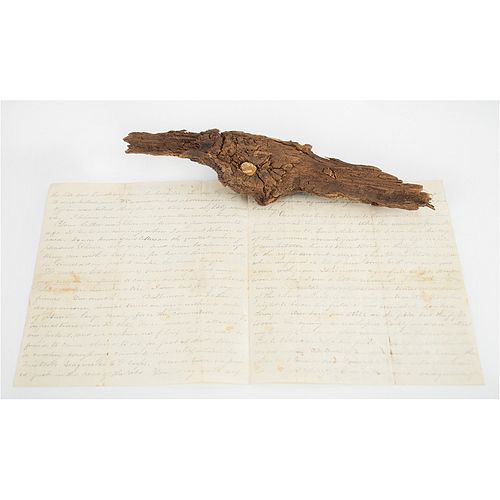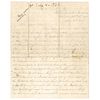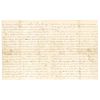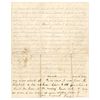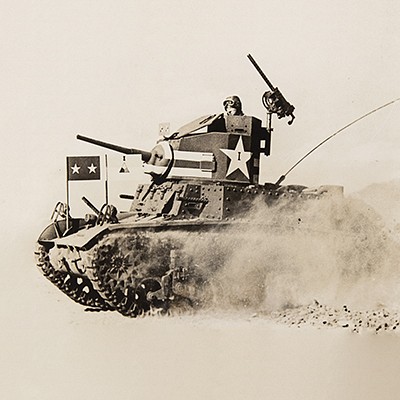Gettysburg Battlefield Letter and Culp's Hill Bullet
Two ways to bid:
- Leave a max absentee bid and the platform will bid on your behalf up to your maximum bid during the live auction.
- Bid live during the auction and your bids will be submitted real-time to the auctioneer.
Bid Increments
| Price | Bid Increment |
|---|---|
| $0 | $5 |
| $50 | $10 |
| $200 | $25 |
| $500 | $50 |
About Auction
May 18, 2023
RR Auction support@rrauction.com
- Lot Description
Remarkable Civil War-dated ALS in pencil by Pvt. Edwin Simmons, a musician in Co. C, Maryland 1st Infantry (Federal), four pages on two adjoining sheets, 6.25 x 8, July 4, 1863. From a "Battlefield near Gettysburg Hospital, 12th Army Corps," Simmons reports on the gruesome scene to his cousin Willie. In part: "When our regiment were drawn up in line of Battle yesterday morning, we were going on the field with them when a surgeon rode up to the Col. and asked him to let us go to the hospital to take care of the wounded‰Û_while our duties were not so dangerous, it was quite as laborious as those of the fighting men. Our regiment went into the fight with a yell and fought bravely all day. They met the 1st Md. Reb. reg—and killed or wounded nearly all of them. Among the killed on their side is ex Capt. Jno. Henry, once Capt. of Co. A of our regiment. The roar of battle has been terrible all day‰Û_Sometimes a shell would come over the hill and burst very near the hospital‰Û_your letters are the greatest source of pleasure I have‰Û_I read them over a dozen times a day just to make them seem longer‰Û_Our march from Baltimore was a rather dangerous one. Several times we were within a mile of Stuart's large cavalry force, the one that committed so many depredations near the city. Once indeed he attacked our pickets (and we captured one of his) but he was afraid to come closer‰Û_a cavalry company came to our relief which he mistook for Sedgwick's 6th Corps. Once or twice we passed just in the rear of the rebs‰Û_Our duties here are to attend the wounded, bring them water, assist the surgeons, take the wounded from the ambulances‰Û_Even while I write I can hear the cry of the wounded around. Just here on my left is a pile of amputated limbs some twenty or thirty in number. To the right are about a dozen ghastly mutilated corpses, while in front is a lot of men some with one arm gone, some with none. It is indeed a fearful sight‰Û_Our boys are still on the field, but the fight is over. The enemy are whip'd badly and are retreating leaving their dead and wounded on the field for us to take care of. The field is filled with their dead. Whole crowds of men are at work burying them‰Û_One or two such sanguinary fights as this will sweep the whole South. We have hundreds of wounded prisoners at the hospital, and they are yet coming in‰Û_Oh Willie! You have seen nothing of soldiering, nothing of the horrors of war. It is not only the labors of marching and fight, of the privation of hunger and thirst and of the exposure to rain and storm, but of the nerves also. The horrid sights that meet the eye almost freeze the blood in one's veins‰Û_Sometimes the moon peeps through the broken clouds to look on the pale lifeless corpse, and anon the thunder crashes through the sky and the rain comes down in torrents‰Û_Won't say any more about it. We are ordered to move from the Hospital‰Û_We leave in the morning." In very good condition, with archival tape repairs to separated folds, scattered creases, and the last several lines re-traced in ink.
This historic letter documents the brother-versus-brother nature of the Civil War, alluding to the fight between Maryland's divided populace—more than 3,000 Marylanders fought on both sides at Gettysburg, most notably at Culp's Hill on the second day. This bloody event is also represented in the lot by a bullet embedded in a section of wood removed from a tree near Culp's Hill: the piece measures 10″ long, and is identified by a tag annotated: "Bullet in wood found near Culp's Hill, one of 72 found in one tree!" Housed together in a Riker box, the letter and relic form a poignant Battle of Gettysburg display. - Shipping Info
-
Bidder is liable for shipping and handling and providing accurate information as to shipping or delivery locations and arranging for such. RR Auction is unable to combine purchases from other auctions or affiliates into one package for shipping purposes. Lots won will be shipped in a commercially reasonable time after payment in good funds for the merchandise and the shipping fees are received or credit extended, except when third-party shipment occurs. Bidder agrees that service and handling charges related to shipping items which are not pre-paid may be charged to a credit card on file with RR Auction. Successful international Bidders shall provide written shipping instructions, including specified Customs declarations, to RR Auction for any lots to be delivered outside of the United States. NOTE: Declaration value shall be the item’(s) hammer price and RR Auction shall use the correct harmonized code for the lot. Domestic Bidders on lots designated for third-party shipment must designate the common carrier, accept risk of loss, and prepay shipping costs.
-
- Buyer's Premium



 EUR
EUR CAD
CAD AUD
AUD GBP
GBP MXN
MXN HKD
HKD CNY
CNY MYR
MYR SEK
SEK SGD
SGD CHF
CHF THB
THB